Most business owners hire virtual assistants to handle their administrative support, email marketing, and other non-core business activities efficiently.
But with hundreds of sites offering virtual assistant services, how do you find the right one?
To help you out, we’ll highlight the three key features to look for in a virtual assistant website and review the 24 best virtual assistant websites for finding skilled VAs. And as a bonus, we’ll also cover how you can monitor your VAs with ease.

Table of Contents
- 3 key features to look for in a virtual assistant website
- Top 24 virtual assistant websites
- 2. Magic
- 3. Virtalent
- 4. Fancy Hands
- 5. Virtual Staff Finder
- 6. Time Etc
- 7. 24/7 Virtual Assistant
- 8. MyOutDesk
- 9. Hello Rache
- 10. Upwork
- 11. Fiverr
- 12. LinkedIn
- 13. VA Networking
- 14. Freelancer.com
- 15. PeoplePerHour
- 16. Zirtual
- 17. Indeed
- 18. Vasumo
- 19. VaVa Virtual Assistants
- 20. BELAY
- 21. Prialto
- 22. Boldly
- 23. UAssist.Me
- 24.Virtual Employee
3 key features to look for in a virtual assistant website
Traditionally, VA websites chiefly featured freelancers like work-at-home moms or solopreneurs who offered specialized VA services.
However, you now have virtual assistant companies that provide skilled VA teams for a host of virtual assistant services.
But how do you select the right virtual assistant website?
An excellent virtual assistant website must have three key features, such as:
- Transparent pricing and payment methods.
- User-friendly interface.
- Tons of positive customer reviews.
Here’s a closer look at each feature and why it matters:
1. Transparent pricing and payment methods
A major concern when dealing with online businesses is the clarity in pricing and payment methods.
Without transparent pricing and payment methods, you won’t be able to know:
- How much you’ll have to pay the VA for their work.
- The pricing scheme used by them — whether it’s an hourly rate or a task-based rate.
- If there are any hidden fees and commissions that inflate your final bill.
- What third-party payment platforms you can use to pay the VA.
To avoid this, visit virtual assistant websites that only have a clear breakdown of VA pricing plans and payment modes. This way, you’ll also know if there are any hidden charges or penalties for the virtual assistant services.
2. Great user interface
You need to sign up for a virtual assistant website that offers a user-friendly experience.
Here’s why:
- A great UI helps to streamline the virtual assistant hiring process easily.
- It helps you quickly find the right VA, with features like advanced search filters and live chat rooms.
If you want to make your VA hiring process effortless, go for a VA website that’s easy to use and understand.
3. Tons of positive customer reviews
What is the best way to choose between websites when in doubt?
Rely on customer reviews!
Check out the reviews and testimonials of different virtual assistant websites to help you determine the one you should go for.
As these reviews are left by clients who have already used the service, you’ll be able to:
- Get an unbiased idea of how efficient the virtual assistant service is.
- Know which websites simplify the VA hiring and management process.
It’s smarter to go for websites with tons of reliable positive reviews and testimonials — they’re more likely to provide you the best virtual assistant services in the industry.
Top 24 virtual assistant websites
Here are the top twenty-five websites for all general virtual assistant services:
1. WoodBows

WoodBows is one of the top virtual assistant service companies in the USA. Entrepreneurs and business owners turn to WoodBows when they need a reliable virtual assistant for their business.
Key features
- Dedicated account manager, daily status update, 24/7 phone or email support. It’s like having your own employee just a click away.
- No contract or set up fee — transparent pricing.
- They only hire the top 1% of virtual professionals after screening through a 3-step hiring process.
The process of hiring a VA
1. Book a free consultation on their website and explain your requirement.
2. They will assign you a dedicated virtual professional along with an account manager.
Pros
- Your unused hours will carry over and will never expire.
- Your virtual assistant will always be available on the phone during your business hours.
- You can create a virtual team without paying extra for various tasks such as website design, email marketing, general admin tasks, cold calling, and so on.
Pricing
WoodBows pricing plans start at $33/hr plan.
2. Magic

Magic provides the best text-based virtual assistance for handling all kinds of business and personal activities — like having a personal assistant for all your needs!
Most companies use Magic to outsource their marketing, customer support, and administrative tasks.
Key features
- Automatic free VA-backups if things don’t work out between you and your current assistant.
- Magic doesn’t require you to pay on early cancellations.
- Magic has third-party plugins with communication tools like Slack and Telegram.
The process of hiring a VA
1. Download the Magic App and sign up.
2. Send texts stating your needs.
3. Magic will assign a team of virtual assistants to your task.
Pros
- You only have to send a text message to get the service.
- No monthly subscription — only pay the VA for the task you assign them.
- Has mobile apps for Android and iOS devices.
Pricing
Pricing plans start at $10/hour per virtual assistant.
3. Virtalent

Virtalent is a UK-based virtual assistant company that helps small business owners hire the most skilled virtual assistants for clerical jobs.
Key features
- Only work with high-quality VAs having an average of 15 years of experience.
- Dedicated client managers help new clients streamline the hiring process.
- Any unused hours in your VA plan automatically roll over to the next month.
The process of hiring a VA
1. Book a free consultation.
2. They’ll match you with the right VA according to your business needs.
Pros
- Pay your VAs only for the time they spent on your work.
- Your requirements are manually reviewed to find the best fitting VA.
- Has flexible VA services with easily switchable plans.
Pricing
Virtalent membership plans start at $361.50/month for 10 hours of VA support.
4. Fancy Hands

Fancy Hands is a US-based VA company for businesses looking to outsource tasks like booking reservations, handling phone calls, and other personal tasks.
Key features
- Its teamwork platform helps you manage multiple virtual assistants efficiently.
- Unused task requests in your VA plan are carried forward to the next month.
- Third-party plugins for project management software to help streamline your project workflows.
The process of hiring a VA
1. Download the Fancy Hands app and sign in.
2. Start submitting as many tasks as you need.
3. The tasks will be assigned to a personal assistant who’ll begin working on them immediately
Pros
- It has a mobile app for Android and iOS devices.
- It auto-assigns the task to the right VA — you don’t have to find a VA manually.
- Easily manage phone calls and schedule client meetings by delegating these tasks to a VA.
Pricing
Pricing plans start at $17.99/month for 3 VA service requests.
5. Virtual Staff Finder

Virtual Staff Finder is a Philippines based virtual assistant business ideal for any small business owner looking to outsource administrative tasks.
Key features
- Provides high-quality virtual assistants with excellent communication skills.
- Pay VAs based on a mutually agreeable pricing scheme.
- Exclusive video assistance and free resources to help you get started with your VAs quickly.
The process of hiring a VA
1. Sign up for the VA service by paying a one-time fee.
2. Fill in the job description form.
3. The sourcing team will manually shortlist three candidates for you.
4. Hire a VA out of the three and begin monitoring their work on your project.
Pros
- Provides 24/7 VA assistance.
- Can directly contact your own virtual assistant without any interference from Virtual Staff Finder.
- Can work with your VA outside the platform at your convenience.
Pricing
Plans start at $395 (one-time fee).
6. Time Etc

Time Etc is a US and UK-based virtual assistant website that provides the best VA services to entrepreneurs and companies. They provide expert VAs with at least two to three years of experience in the VA industry.
Key features
- Time Etc has a powerful dashboard showing all your VAs and tasks in one place.
- Unused VA work hours can be carried forward to the next month.
- Hire VAs from the Time Etc Community to get the best-rated virtual assistants.
The process of hiring a VA
1. Apply for a free trial or book a consultation.
2. Purchase a pricing plan.
3. The team will then take you through a 10-step VA hiring process.
Pros
- VAs respond to your service queries instantly.
- Can create a virtual team of a maximum of 15 VAs.
- Supports unlimited phone calls with your VAs.
Pricing
Time Etc’s pricing plans start at $380/month for 10 hours of unlimited task requests.
7. 24/7 Virtual Assistant
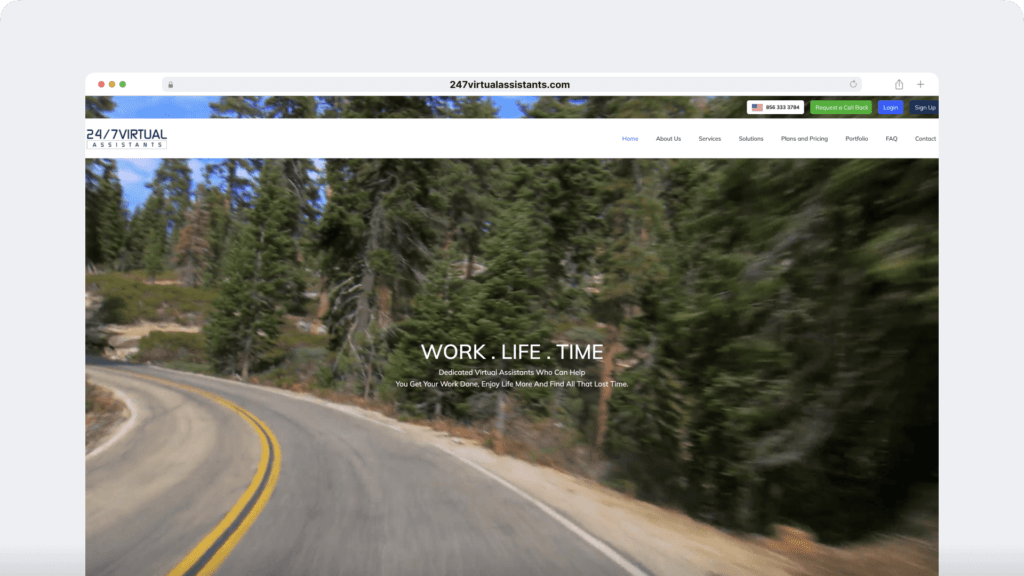
24/7 Virtual Assistant is a virtual assistant business offering top virtual assistance for personal tasks like food delivery and ticket booking. It also provides administrative task support, email marketing, homepage, and search engine optimization services.
Key features
- As the domain name suggests, VAs are available 24/7.
- The service can be canceled at any time without incurring a penalty fee.
- Real-time customer support for resolving issues instantly.
The process of hiring a VA
1. Select a membership plan.
2. Determine the type of service you require, and they’ll match you with the right VA.
Pros
- Access to an extensive list of in-house expert VAs.
- Can choose from US-based or offshore VAs.
- Can also hire a full-time virtual employee.
Pricing
Plans for VA working from an offshore office start at $349. And pricing plans for VAs located in the U.S. starts at $399.
8. MyOutDesk

MyOutDesk is one of the most trusted virtual assistant platforms for real estate services. It also provides digital marketing services like SEO, social media management, and Google advertising to help attract ideal clients for your real estate business.
Key features
- MyOutDesk has no lock-up periods — you can cancel the VA services at no extra cost.
- MyOutDesk provides tons of data security and legal protection over your VA activities and transactions.
- Integrates with project management software to help improve your business processes.
The process of hiring a VA
1. Visit their website to book a consultation with them.
2. State the type of VA you want to hire.
3. They will assign the perfect candidate for you.
Pros
- Ensures liability reduction to prevent client reputation damage.
- Has a strict talent matching process, ensuring that you get high-grade VAs.
- Has hundreds of positive client reviews and testimonials.
Pricing
MyOutDesk pricing plan starts at $1988/month.
9. Hello Rache

Hello Rache is a popular virtual assistant service provider for medical professionals. While it’s based in the United States, it provides Filipino work-from-home assistants for a host of healthcare and administrative tasks.
Key features
- HIPAA-compliant virtual assistants who ensure data confidentiality.
- Video resumes of VAs to help you get a clear idea of who you’ll be working with.
- Provides healthcare VAs skilled in EHR (Electronic Health Record) software, Practice Fusion, and other patient management systems.
The process of hiring a VA
1. Sign up for the service.
2. Discuss your VA requirements with the operations team.
3. They’ll assign the right VA accordingly.
Pros
- Quick setup and user-friendly interface.
- Offers custom VA solutions tailored to your needs.
- No contract or registration fees for availing services.
Pricing
Hello Rache has a flat rate of $9.50/hour.
10. Upwork

Upwork is a popular website for any potential client looking to hire freelancers. It offers virtual assistance for data entry, social media management, graphic design, and WordPress site development.
Key features
- Advanced search filters to help you find the right VA quickly.
- The Upwork team account helps you manage multiple freelancers in one place.
- A built-in work diary that enables you to estimate the total billable time of each VA.
The process of hiring a VA
1. Create an Upwork account.
2. Post a job description or invite VAs to submit their quotes.
3. Review the received proposals.
4. Interview the candidates.
5. Click ‘hire’ on the selected proposal to get started.
Pros
- Has an intuitive user interface.
- Pay the VA only after you’ve monitored their activities and are satisfied with their work.
- Has a mobile app (for Android and iOS devices) to connect with your VA on the go.
Pricing
Upwork’s membership plans start at $49.99/month.
11. Fiverr

Fiverr is perfect for any small business looking to hire virtual assistants for tasks like web design, copywriting, and podcast editing. It lets you browse through tons of skilled VA profiles to help you find the right one.
Key features
- Highlights expert VAs to help you hire the best talents.
- Multiple search filters to help you zero in on the right VA quickly.
- High-quality customer support with quick response times for your queries.
The process of hiring a VA
1. Register yourself on Fiverr.
2. Browse VA profiles according to your business needs.
3. Hire the VA you find the best fit and monitor them to ensure the work is done.
Pros
- You’ll know what you’ll have to pay the VA before contacting them.
- Pay the VA only when you’re satisfied with their work.
- All transactions are done on the Fiverr platform, ensuring high-security standards.
Pricing
All service purchases have a $2 processing fee for service rates up to $40 and 5% on rates above $40.
12. LinkedIn

LinkedIn is one of the largest and most popular business and employment networks – and it’s still growing rapidly. It provides a platform to connect with professionals and VAs around the world.
Key features
- Automatically generated job descriptions and templates to create the best-suited job description.
- Standardized fields like location, industry, skills, and years of experience to find the right match.
- Screening questions and skills assessments to quickly see candidates that match your qualifications.
The process of hiring a VA
1. Create your company profile.
2. Post job openings for hiring a VA.
3. Reach out to candidates via InMail.
4. Screen candidates to hire a VA that suits you best.
Pros
- Personalized emails, search results, and push notifications to target relevant virtual assistant job seekers.
- Filter, sort, and rate applicants to receive similar candidate recommendations.
- Easy-to-use applicant management tools to share and review candidate profiles with your team.
Pricing
Employers can post a job opening for free or set a budget to increase a job’s promotion.
13. VA Networking
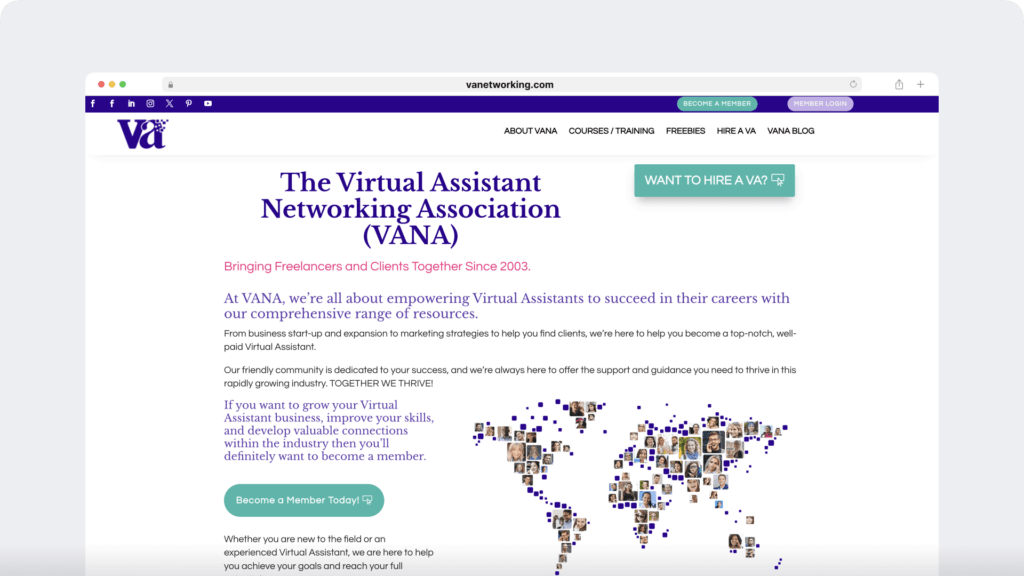
VA Networking is a one-stop platform to find beginners as well as experienced virtual assistants. It offers many free resources to learn everything about virtual assistance, networking with employers and other VAs, and finding work.
Key features
- Post your requirements on the job board and directly talk to experienced VAs.
- VA networking forum to find support from other virtual assistants.
- Offers a career startup system to gain work experience for becoming a successful virtual assistant.
The process of hiring a VA
1. Fill out a detailed form on their website.
2. VA Networking will post your Request For Proposal (RFP) on its job board.
2. The RFP responses will be emailed directly to you from members that meet your given criteria.
Pros
- All Request For Proposals (RFP) are free to submit on the VAinsiders.com member job board.
- Offers 200+ client services, including bookkeeping, e-commerce site setup, and travel planning.
- Provides a free ebook to help find the ultimate VA for your business.
Pricing
You can submit your RFPs for free.
14. Freelancer.com

Freelancer is an Australia-based platform where businesses and individuals can hire freelancers to work across job categories like software, sales, and telecommunications.
It uses a Milestone Payment system that releases payments when your VAs have finished the given task and you’re 100% satisfied with it.
Key features
- Live chat to receive constant updates on the progress of your work.
- Desktop app for Windows, Linux, or Mac to track work hours and employee monitoring.
- Employer Following feature to let freelancers know when their preferred employer has posted a project.
The process of hiring a VA
1. Post a task or project.
2. Wait to receive competitive bids from freelancers.
3. Browse through freelancer profiles and compare proposals.
4. Chat with them and make your pick.
Pros
- Supports work across 1800 categories.
- Allows job seekers to compete with other freelancers in contests to prove their skills.
- Freelancer showcase to quickly find popular project ideas and hire a freelancer most suited to your job requirements.
Pricing
Freelancer.com is free to post a project. However, you have to pay an additional 3% fee while paying your freelancers.
15. PeoplePerHour

PeoplePerHour is a popular job site for freelancers and virtual assistants.
You can name your services, set hourly rates, and wait for candidates — or directly search for prospective clients who need your services and submit a proposal.
Key features
- Offers VAs across various industries like technology, writing, and digital marketing.
- Filter to help sort search results by language, popularity, availability, and more.
- Dashboard to overview the entire hiring process.
The process of hiring a VA
1. Post a project with relevant details.
2. PeoplePerHour connects you with the best possible matches.
3. Pick your candidate and pay a deposit to start.
Pros
- Access to global talent.
- Supports businesses of all sizes.
- Integrates with various payment platforms like PayPal.
Pricing
PeoplePerHour doesn’t charge you for signing in or posting a job offer.
16. Zirtual

Zirtual is a virtual assistant company that helps expand your business reach and find potential clients. They provide businesses with a virtual administrative assistant who can handle data entry, research, event planning, and other tasks.
Key features
- Calendar management for scheduling appointments, team meetings, and events.
- Helps with expense reporting and organization and sending invoices.
- Social media virtual assistant for creating social media account posts to increase audience engagement,
The process of hiring a VA
1. Request a consultation to clear any doubts.
2. Pick a subscription plan.
3. Setup a kickoff delegation strategy call to get started.
Pros
- All assistants are college-educated and are based in the US.
- Directly contact your dedicated virtual assistant via phone, SMS, and email.
- Virtual assistants go through background checks.
Pricing
Plans start at $549/month for 12 hours of task work.
17. Indeed
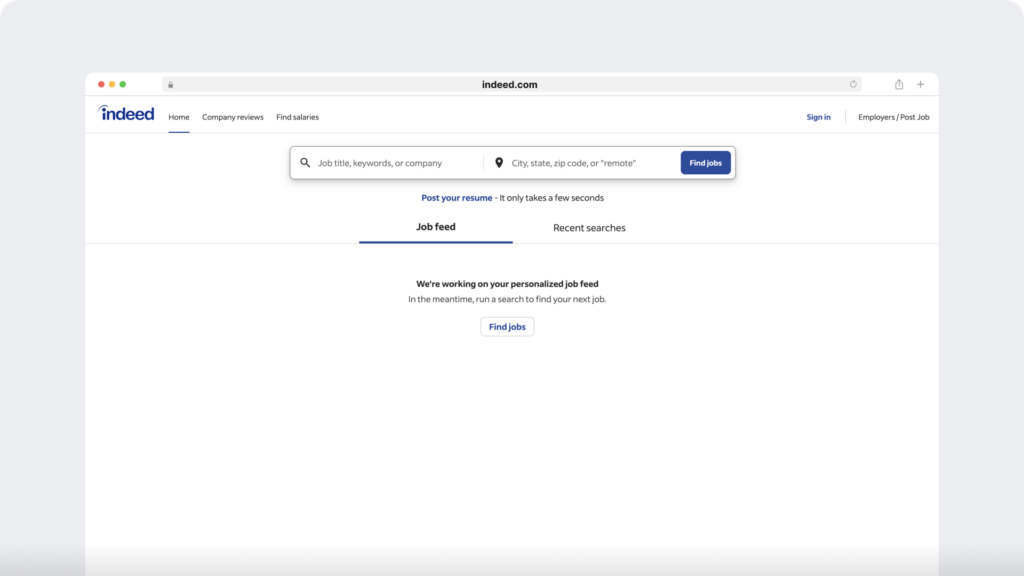
Indeed is a free platform for virtual assistant talent, where VAs can upload their resume, create job alert emails, search for jobs, save them and apply to them directly.
It also includes job listings from major job boards, newspapers, associations, and company career pages. Employers can also post jobs directly to Indeed.
Key features
- Indeed Assessments to screen for the skills you’re looking for.
- Automatically groups candidates based on requirements.
- Allows companies to their own recruitment systems with Indeed.com
The process of hiring a VA
1. Build your job post by adding a title, description, and location.
2. Post your job on the platform.
3. Use the in-built tools to find a suitable VA.
Pros
- Helps automate screening, scheduling, and communication.
- Sponsored jobs attract more candidates to your career site.
- Allows candidates to apply from any device.
Pricing
You can post VA jobs for free on Indeed. You can also pay to post a sponsored job (contact support for pricing details).
18. Vasumo

Vasumo offers plans for beginner entrepreneurs, a growing company as well as individuals.
They provide assistants who are trained in a wide variety of skills and have a minimum of three years of experience.
Key features
- Tasks management dashboard for organizing and easy communication.
- Chat Widget to connect with the Client Happiness Team for doubts and queries.
- Offers Web, smartphones, and tablet apps to connect on the go.
The process of hiring a VA
1. Choose a plan.
2. Add a task with clear instructions to get started.
Pros
- VAs can help you design business websites and landing pages.
- Allows you to hire a graphic designer who can create social media posts, logos, and business cards.
Pricing
Pricing plans start at $598/month for up to 20 hours of monthly service.
19. VaVa Virtual Assistants

VaVa Virtual Assistants is ideal for the entrepreneur looking to jumpstart their business. They offer skilled assistants in bookkeeping, social media, branding, graphic design, web design, and more.
Key features
- Digital and social media marketing services for copywriting, blog writing, and online advertising.
- Hire an executive assistant to help with travel booking, calendar, and appointment setting.
- Graphic design services to create logos, custom branded graphics, and promotional images.
The process of hiring a VA
1. Fill out the detailed form on the Contact Us page.
2. Their team will get in touch to understand your needs.
Pros
- Eliminates office and equipment expenses.
- Saves on payroll taxes, insurance, and other employee benefits.
- Manages administrative tasks to save time for core tasks.
Pricing
Contact sales for a custom quote.
20. BELAY

Belay is a great virtual staffing solution if you’re looking to hire a VA, virtual bookkeeper, social media strategist, or web specialist. They provide VAs with at least five years of working experience and some remote work experience.
Key features
- VAs are available from Monday to Friday, 9 AM – 5 PM
- Helps you with tasks like managing your inbox and executing travel plans.
- Assists in gathering industry data and research.
The process of hiring a VA
1. Fill in the form and talk with someone on the team.
2. They’ll understand and assess your needs.
3. Once the agreement is signed, a Client Success Consultant will guide you.
4. They’ll find the right VA for you.
Pros
- Contractors sign a confidentiality agreement to protect sensitive information.
- VAs are available for executives, sales teams, managers, authors, and more.
- All VAs have bachelor’s or higher degrees.
Pricing
Contact support for a direct quote.
21. Prialto

Prialto is a US-based virtual assistant company focused on supporting executives.
It provides a highly trained team of managed, dedicated virtual assistants who can easily adapt to business goals and preferences.
Key features
- Can research, create viable lists, and respond to reviews.
- Schedule meetings at optimal times and manage calls.
- Workflow management to manage appointments and tasks.
The process of hiring a VA
1. Requirement assessment and draft an implementation.
2. Meet your virtual assistant and support team.
3. Delegate key tasks to your new assistant.
Pros
- Offers trained primary and secondary backup assistants.
- Easily increase or decrease support without any disruptions.
- Takes comprehensive information security measures.
Pricing
Plans start at $1500 per unit /month for 55+ hours of monthly service.
22. Boldly

Boldly, previously known as Worldwide101, is one of the top virtual assistant companies. They offer the highest quality, skilled, and reliable virtual assistants that provide top-notch services.
Key features
- Client dashboard to keep track of your VA’s tasks and time.
- Your VA will train a backup to cover during vacation or illness.
- Integrate VAs into your workspace through company email and other collaboration tools.
The process of hiring a VA
1. Share your requirements.
2. Meet your candidate via video calls to check compatibility and skills.
3. Start working with the hired staff member.
Pros
- Meet your VA before deciding to work together.
- Multilingual VAs in languages like French, German, and Spanish.
- Offers services for businesses of all sizes.
Pricing
Pricing plans start at $2360/month for 40 hours of service.
23. UAssist.Me

UAssist.Me provides virtual assistants and outsourcing services for startups, small businesses, and entrepreneurs. Here, you can find highly skilled assistants that specialize in administrative and clerical work for several industries.
Key features
- Provides UAM app to keep track of projects on the go.
- Helps with personal errands like online purchasing, research, and more.
- Bilingual virtual assistants to help with translation and transcription.
The process of hiring a VA
1. Choose a plan.
2. Fill out the job description of the services you want to hire.
3. The UAssist.Me team will help you get started.
Pros
- Offers virtual assistant services for administrative as well as creative tasks.
- Virtual assistants are college-educated and pre-trained.
- Customer support for inbound, outbound, email, and live chat.
Pricing
Plans start at $1059/month for a shared assistant.
24.Virtual Employee

Virtual Employee is another excellent solution if you are looking for a VA business. They provide virtual employee services across domains like software programming, law, accounts, and other non-technical areas.
Key features
- Offers 1-week free trial.
- Provides virtual assistants for data entry, customer support, and more.
- You can cancel your VA contract at any time.
The process of hiring a VA
1. Send requirements through the contact us page.
2. The Virtual Employee team will assess and provide a quote.
3. Choose your team members.
4. Start services within 8 hours.
Pros
- Allows you to select your own resources.
- Offers 24×7 support.
- Provides virtual staffing services in 150+ domains.
Pricing
Plans start from $995/month.
Here’s a comparison table of the top 24 virtual assistant websites to help you find skilled VAs:
| Website | Key Features | Pros | Pricing |
|---|---|---|---|
| WoodBows | Dedicated account manager, no contract, top 1% VAs | Unused hours carry over, 24/7 support, multi-tasking capabilities | Starts at $33/hr |
| Magic | Text-based assistance, no early cancellation fees, Slack/Telegram plugins | Easy to use, no monthly subscription, mobile apps available | Starts at $10/hr |
| Virtalent | High-quality VAs, dedicated client managers, unused hours roll over | Pay only for worked hours, manual requirement review, flexible services | Starts at $361.50/month for 10 hrs |
| Fancy Hands | Teamwork platform, unused requests carry over, project management plugins | Mobile app, auto-assign tasks, manage calls/meetings | Starts at $17.99/month for 3 tasks |
| Virtual Staff Finder | High-quality VAs, mutually agreeable pricing, exclusive video assistance | 24/7 assistance, direct contact with VAs, flexible engagement | $395 one-time fee |
| Time Etc | Powerful dashboard, unused hours carry forward, community of top VAs | Instant responses, create a team of 15 VAs, unlimited calls | Starts at $380/month for 10 hrs |
| 24/7 Virtual Assistant | 24/7 availability, no penalty for service cancellation, real-time support | Extensive in-house VAs, choose US-based or offshore VAs, hire full-time VAs | Offshore: $349/month; US: $399/month |
| MyOutDesk | No lock-up periods, data security, integrates with project management software | High-grade VAs, strict talent matching, many positive reviews | Starts at $1988/month |
| Hello Rache | HIPAA-compliant, video resumes, EHR software skilled VAs | Quick setup, custom VA solutions, no contract fees | $9.50/hr |
| Upwork | Advanced search filters, team account, built-in work diary | Intuitive interface, pay after monitoring, mobile app | Starts at $49.99/month |
| Fiverr | Expert VAs highlighted, multiple search filters, high-quality support | Transparent pricing, pay after work completion, secure transactions | $2 processing fee (services up to $40); 5% above $40 |
| Auto-generated job descriptions, standardized fields, screening questions | Personalized emails, filter and rate applicants, easy management tools | Free or set budget for promotion | |
| VA Networking | Job board, networking forum, career startup system | Free RFP submission, over 200+ client services, free ebook | Free to submit RFPs |
| Freelancer.com | Live chat, desktop app for tracking, employer following feature | 1800+ categories, freelancer contests, project ideas showcase | Free to post project; 3% fee on payments |
| PeoplePerHour | Various industries, filter search results, dashboard overview | Global talent, supports all business sizes, integrates with payment platforms | Free to post job offer |
| Zirtual | Calendar management, expense reporting, social media assistants | College-educated US-based VAs, direct contact, background checks | Starts at $549/month for 12 hrs |
| Indeed | Assessments, automated candidate grouping, integrated with recruitment systems | Automates screening/scheduling, sponsored job promotion, mobile-friendly | Free or pay for sponsored jobs |
| Vasumo | Task management dashboard, chat widget, apps for web/mobile/tablet | Business website/landing page design, graphic designer hiring | Starts at $598/month for 20 hrs |
| VaVa Virtual Assistants | Digital/social media marketing, executive assistant services, graphic design | Saves on office expenses, payroll taxes, manages admin tasks | Custom quotes |
| BELAY | Experienced VAs, various tasks, data gathering, and research | Confidentiality agreements, available for executives/managers/authors, all VAs with degrees | Contact for pricing |
| Prialto | Executive support, trained team, workflow management | Backup assistants, flexible support, information security | Starts at $1500/month for 55+ hrs |
| Boldly | Client dashboard, backup training, workspace integration | Meet VA before hiring, multilingual VAs, supports all business sizes | Starts at $2360/month for 40 hrs |
| UAssist.Me | UAM app, personal errands, bilingual VAs | Admin and creative task services, college-educated VAs, customer support | Starts at $1059/month |
| Virtual Employee | Free trial, various domains, cancel anytime | Choose own resources, 24×7 support, 150+ domains | Starts at $995/month |
Feel free to use this table to compare and choose the best virtual assistant service for your needs.
How to easily monitor your VAs
Remember, it’s essential to monitor the work your VAs do for you.
Because, how else would you know if your VAs are actually working on your projects and not billing you for idle hours?
Fortunately, with smart performance monitoring tools like Time Doctor, you’ll have everything you need to monitor your VA’s work hours.
What’s Time Doctor?

Time Doctor is a powerful employee productivity management software used by large companies like BBB (Better Business Bureau) as well as small businesses, like Firehouse Subs, to enhance their employees’ productivity.
Here’s a closer look at how it helps you monitor your remote worker:
1. Keep track of your VAs work hours
Time Doctor’s Project Reports give you a detailed breakdown of the hours worked by your virtual assistants on each project. It shows you who worked on each task and the time they spent on it.
As these reports are highly accurate, you can use them to track the hours worked by your virtual assistants to ensure you pay them accordingly.
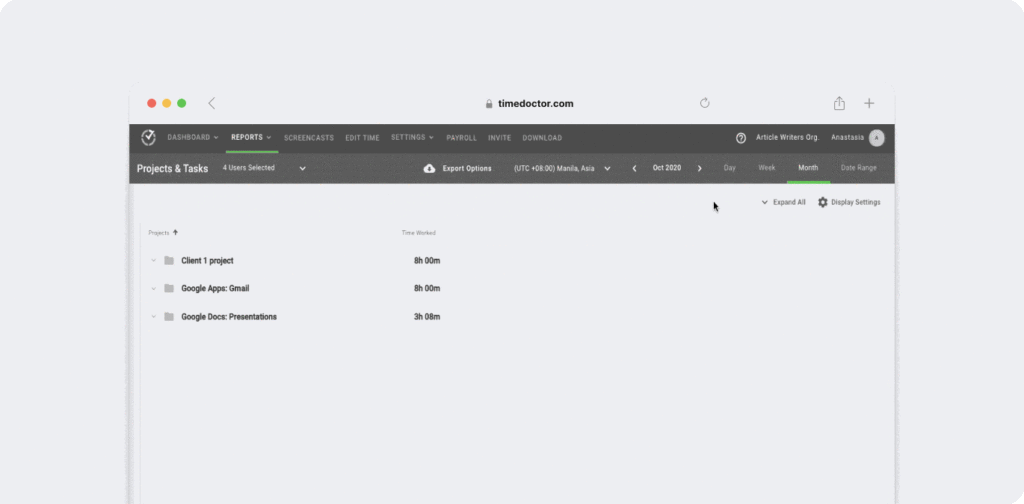
2. Prevent VAs from billing you for idle work hours
Time Doctor comes with a built-in inactivity tracker that tracks your VA’s activity while they work. The tool automatically pauses the timer if they’re idle for more than the limit set by the manager.
This way, the VAs can only log active hours as hours worked.
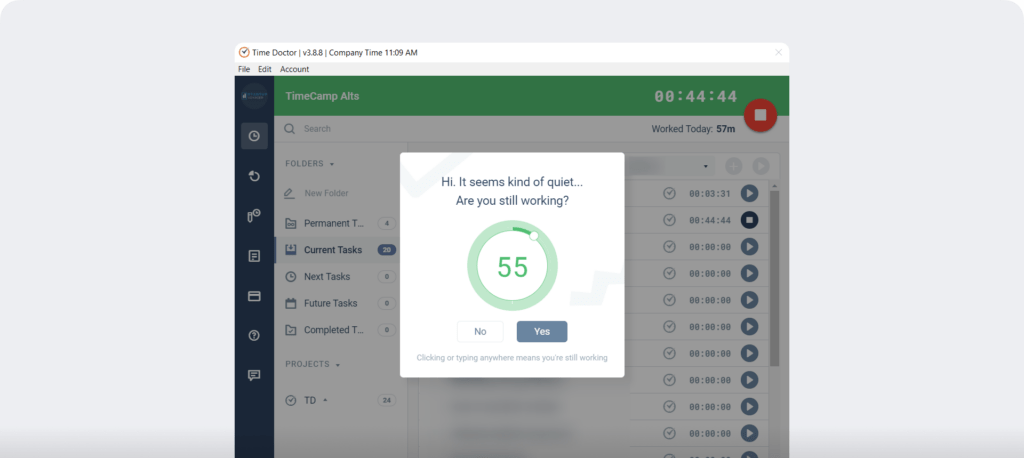
Note: To protect user privacy, Time Doctor does NOT track which keyboard keys are pressed by the user; it only determines if any keys are pressed or not.
3. Ensure that your VAs are focused on their work
Worried if your VAs will be distracted by unproductive websites and apps while working?
With Time Doctor, you won’t be!
It automatically nudges the VAs with a poor time use pop-up alert if they access non-work-related websites and apps or social media like Facebook during work hours. This nudge is usually enough to get them back to work.
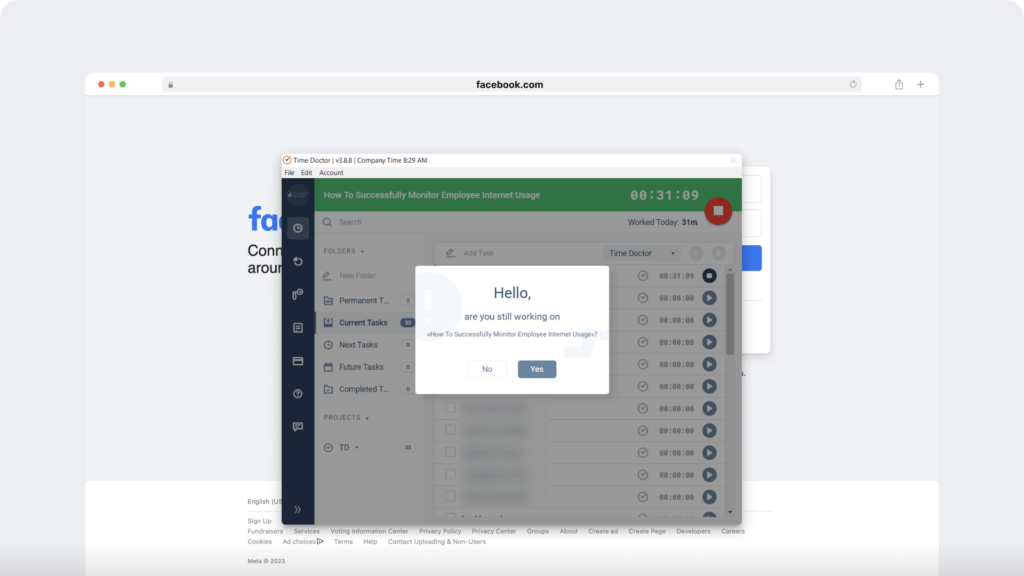
Note: Time Doctor does NOT track the activities performed on any website or app.
4. Easily pay your VAs based on their hours worked
Time Doctor’s payroll management feature automatically calculates each VA’s pay based on their fixed salaries or working hours. It lets you easily pay your VAs for their services using PayPal, Payoneer, or other payment modes of your choice.
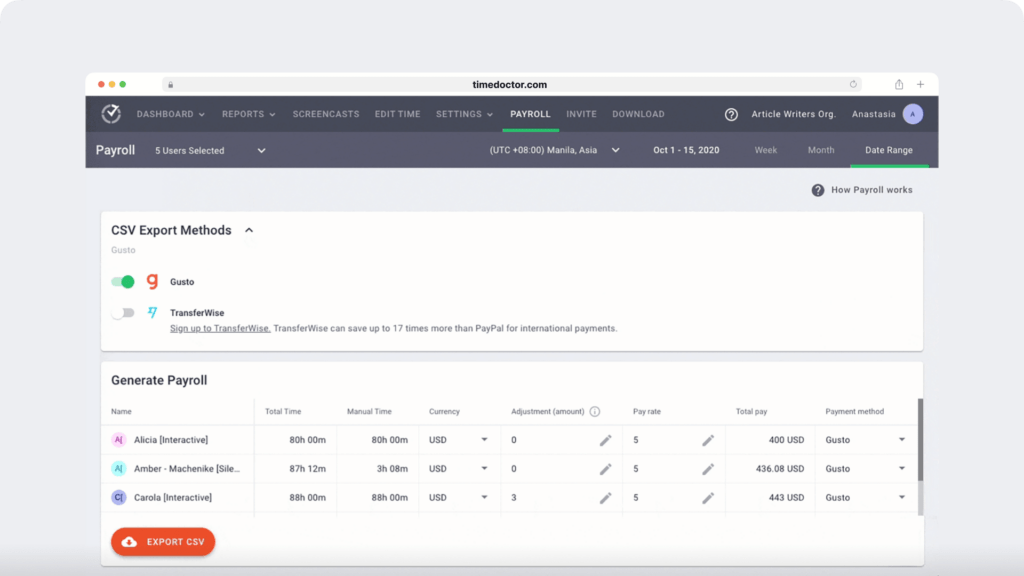
You can also check out our list of virtual assistant software.
Wrapping up
Hiring a virtual assistant doesn’t have to be complicated.
With an excellent virtual assistant website, you can easily hire your own virtual assistant in no time!
Start by trying out the sites we listed here, and you’ll quickly find a talented virtual assistant to manage your tasks efficiently.


